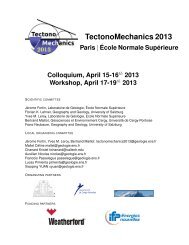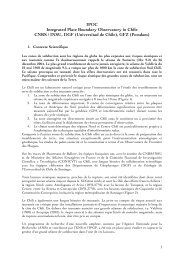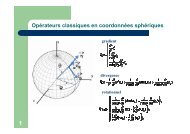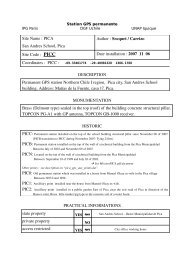PDF file - Laboratoire de Géologie de l'Ecole normale supérieure - Ens
PDF file - Laboratoire de Géologie de l'Ecole normale supérieure - Ens
PDF file - Laboratoire de Géologie de l'Ecole normale supérieure - Ens
You also want an ePaper? Increase the reach of your titles
YUMPU automatically turns print PDFs into web optimized ePapers that Google loves.
X - 8 SIMONS ET AL.: GPS MEASUREMENTS IN S.E. ASIA TO REFINE SUNDALAND MOTION<br />
timated by using a small velocity residual criteria (3 mm/yr) and a<br />
well-balanced choice out of over 40 sites in both the core and the<br />
boundary zones of Sundaland. Although the GPS vector field presented<br />
here provi<strong>de</strong>s good coverage on S.E. Asia, there is a higher<br />
<strong>de</strong>nsity of GPS points in Thailand and Malaysia. Therefore in a<br />
first pole estimation, 17 sites with similar spacing within Sundaland<br />
were selected. Initially, also all stations were equally weighted to<br />
minimize the effect of any bad fitting site(s) with small velocity<br />
sigmas (eg. permanent GPS sites). Only sites that had horizontal<br />
(normalized) residuals smaller than 3 mm/yr were kept into the<br />
computations. In subsequent steps, additional sites that fit well the<br />
initial pole(s) were ad<strong>de</strong>d to the pole estimations. This led to a<br />
Sundaland pole based on 28 of the 40+ available GPS velocities.<br />
Almost all the rejected points were located in the boundary zones of<br />
Sundaland with its neighboring plates. In a final step, the computation<br />
was repeated, only this time the selected points were weighted<br />
according to their individual velocity errors. This is also necessary<br />
to get a realistic error estimate on the pole location and rotation<br />
rate. Furthermore, the more accurate velocities should be allowed<br />
to contribute relatively more to the pole estimation. In any case, the<br />
pole location and rotation rate remained stable throughout all the<br />
subsequent software runs.<br />
With the expan<strong>de</strong>d GPS vector field, the Sundaland block rotates<br />
clockwise at a rate of 0.341Æ/Myr about a pole located 48.9ÆS and<br />
85.8ÆE in ITRF-2000. The (3-error on this pole is 2.01Æfor<br />
the long axis of the ellipse, oriented 21ÆNNW and 0.24Æfor the<br />
short one. The uncertainty on the rotation rate is 0.006Æ/Myr. The<br />
ellipse error is obtained using the method <strong>de</strong>scribed by DeMets et al.<br />
[1994]. The residual velocities of all Sundaland sites with respect to<br />
this pole are shown in Figures 5 in 6. For the 28 sites inclu<strong>de</strong>d in the<br />
pole estimation, the residual velocities are all below 3 mm/yr (circle<br />
radius in Fig. 5), and more than half are smaller than 2 mm/yr. The<br />
exclu<strong>de</strong>d sites are almost all located in <strong>de</strong>forming regions near the<br />
Sundaland boundaries (Sabah province in East-Malaysia, Central<br />
Java, Bali, Sumatra and northwest Thailand/Myanmar).<br />
4.2. Pole comparison and history<br />
Although the initial results of the GEODYSSEA project [Wilson<br />
et al., 1998; Simons et al., 1999] were plagued by not-well<br />
Table 7. Overview of published Sundaland poles.<br />
Reference Reference Sites Pole Rotation parameters<br />
frame used Lat(ÆS) Lat(ÆE)Æ/Myr)<br />
GEODYSSEA<br />
Wilson et al. [1998] ITRF-94 12 31.8Æ 134.0Æ-0.280Æ<br />
Simons et al. [1999] ITRF-96 12 43.0Æ 119.0Æ-0.370Æ<br />
Michel et al. [2001] ITRF-97 10 56.0Æ 77.0Æ-0.339Æ<br />
This paper ITRF-00 28 48.9Æ 85.8Æ-0.341Æ<br />
Others<br />
Sella et al. [2002] ITRF-97 3 38.9Æ 93.1Æ-0.393Æ<br />
Kreemer et al. [2003] NNR 9 47.3Æ 89.8Æ-0.392Æ<br />
Bock et al. [2003] ITRF-00 16 49.8Æ 84.1Æ-0.320Æ<br />
Table 8. Differences in predicted motions w.r.t. previous poles.<br />
Differences horizontal motions (mm/yr)<br />
Indochina Sunda Shelf South Borneo<br />
Reference 15ÆN105ÆE 5ÆN110ÆE -5ÆN115ÆE<br />
North East North East North East<br />
This paper (ref. val.) -8.2 31.8 -10.2 30.5 -12.2 26.6<br />
GEODYSSEA<br />
Wilson et al. [1998] +21.1 -11.9 +21.0 -12.0 +20.8 -12.4<br />
Simons et al. [1999] +15.5 +0.9 +15.0 +0.1 +14.2 -1.3<br />
Michel et al. [2001] -1.7 +1.3 -1.3 +2.2 -0.8 +3.1<br />
Others<br />
Sella et al. [2002] +1.2 +1.4 +0.3 -0.3 -0.5 -2.0<br />
Kreemer et al. [2003] +0.5 +4.6 -0.1 +3.9 -0.4 +3.0<br />
Bock et al. [2003] +0.1 -1.9 +0.2 -1.6 +0.4 -1.2<br />
constrained mapping issues into ITRF-94/96, an adjustment of the<br />
velocity vectors after only 2 measurements campaigns already confirmed<br />
and provi<strong>de</strong>d some good insights in the relative motion of<br />
Sundaland with respect to Eurasia [Chamot-Rooke et al., 1998].<br />
[Michel et al., 2001] inclu<strong>de</strong>d the 3rd observation round of the<br />
GEODYSSEA project, and provi<strong>de</strong>d a further refined Sundaland<br />
pole vector in ITRF-97.<br />
In the last 2 years, 3 papers have been published which present<br />
a ’new’ Sundaland pole. The Sella et al. [2002] paper does this by<br />
using only 3 IGS sites (BAKO, NTUS, KUNM), of which 2 not yet<br />
have very accurate velocities in ITRF-97 and 1 is not even located on<br />
Sundaland. The second paper is by Kreemer et al. [2003], which has<br />
ma<strong>de</strong> use the geo<strong>de</strong>tic solution of Michel et al. [2001], and consi<strong>de</strong>red<br />
8 GEODYSSEA sites on Sundaland and ad<strong>de</strong>d the IGS station<br />
Singapore. A third paper by Bock et al. [2003], presents results on<br />
the Indonesian archipelago, and thereby also <strong>de</strong>fines a Sundaland<br />
(there named Sunda Shelf) motion, based on Indonesian data for 10<br />
sites, IGS stations BAKO/NTUS/TAIW in/near S.E. Asia and 3 IGS<br />
sites located in South-China (SHAO/WUHN/XIAN).<br />
The history of the angular velocities for Sundaland published both<br />
by the GEODYSSEA project and others is given in Table 7.<br />
In or<strong>de</strong>r to <strong>de</strong>termine if these other Sundaland poles provi<strong>de</strong> a<br />
better (geo<strong>de</strong>tical) <strong>de</strong>scription of the Sundaland motion than Michel<br />
et al. [2001], it first is important to know how much different the<br />
predicted velocities are within Sundaland. For 3 geographically<br />
spread locations within Sundaland, the differences of the predicted<br />
velocities with respect to the updated Sundaland pole presented in<br />
this paper are shown in Table 8. Also inclu<strong>de</strong>d are the previous<br />
Sundaland poles computed during the GEODYSSEA project.<br />
In Table 8, clearly the mapping problems in ITRF-94 and ITRF-<br />
96 can be observed. The Wilson et al. [1998] solution shows almost<br />
constant offsets w.r.t. the solution in this paper which is taken as<br />
reference. Mainly Helmert translations have offset the velocity vectors<br />
that were used to compute the angular velocities. The second<br />
GEODYSSEA solution by Simons et al. [1999] has already a better<br />
mapping, but still the north velocity component generated by the<br />
Sundaland pole presented there is off by about 15 mm/yr. These<br />
offsets were caused by the use of only 5 IGS sites (YAR1, TIDB,<br />
TSKB, TAIW, KIT3) for the mapping into the ITRF. At least 2 of<br />
these sites (TAIW and KIT3) didn’t follow the linear ITRF-94/96<br />
trend during the first 2 GEODYSSEA campaigns, thereby affecting<br />
the mapping. The final geo<strong>de</strong>tic GEODYSSEA paper by Michel<br />
et al. [2001], the Sundaland pole appears to have stabilized quite<br />
well, as the differences with the ’newer’ Sundaland poles are within<br />
3-5 mm/yr. This was achieved by adding one more observation<br />
round, data from additional IGS stations, and mapping the velocity<br />
field into the ITRF-97. The predicted velocities using the 3 Sundaland<br />
poles from the other 3 papers [Sella et al., 2002; Kreemer et al.,<br />
2003; Bock et al., 2003] are within a few mm/yr (roughly the size of<br />
their velocity errors) of the reference values that are obtained with<br />
the Sundaland pole <strong>de</strong>rived in this paper.<br />
Furthermore, also the amount, location and the produced velocity<br />
residuals of sites within Sundaland are an important factor to<br />
<strong>de</strong>termine the quality of the previously published poles. In combination<br />
with the discussion about the final GEODYSSEA and the<br />
’newer’ 3 Sundaland poles given above, the pole of Sella et al.<br />
[2002] is based on the weakest velocity constraints. The Kreemer<br />
et al. [2003] pole for Sundaland has predicted offsets that are similar<br />
to the ones of Michel et al. [2001], but they are larger in the<br />
east component throughout the longitudinal range. Probably the<br />
reference frame (NNR) is not fully compatible with ITRF-2000 for<br />
the Sundaland block, as the majority of the velocity estimates is<br />
i<strong>de</strong>ntical to Michel et al. [2001]. The Bock et al. [2003] paper un<strong>de</strong>restimates<br />
the east velocity component by 1-2 mm/yr, and the<br />
pole stability appears to <strong>de</strong>pend mostly on the inclusion of IGS sites<br />
in N-S direction up to South-China, as the N-S spread of the local<br />
Indonesian data is only a few hundred kilometers and most of the<br />
Indonesian sites are in/near the Sundaland <strong>de</strong>formation zones. This<br />
is confirmed by the relatively higher velocity residuals in the east<br />
components up to 1 cm/yr for the Indonesian sites (including the






